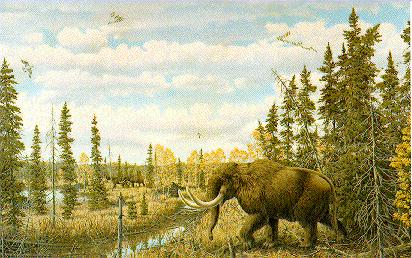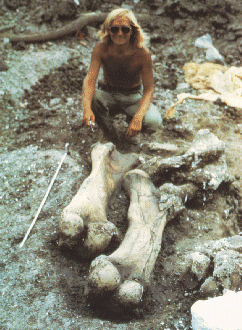
This mural by R.G. Larson in the Illinois State By 16,000 years ago the height of the last major glaciation
The landscape of the Midwest was very different 16,000 years ago. Although glaciers were retreating, much of the midwestern U.S. was still under ice. Some areas had been only recently deglaciated. These areas may have been covered with bare sheets of till that were slowly being revegetated. Large, proglacial lakes formed where morraines dammed the water coming off the melting glaciers. Dust storms were depositing thick layers of loess (windblown dust) over many areas. Lakes, marshes, and mires were common.
Sixteen thousand years ago the climate was quite different in the area. Temperatures in the summer were significantly cooler than today. Winter temperatures were colder than those experienced today but not dramatically so.
Because of the cooler climate, many of the plants and animals that inhabited the area around 16,000 years ago were different than those found in the region today. This can be seen in the reconstruction above.
The reconstruction shows several mastodons feeding in wetlands in a parkland dominated by spruce and balsam (poplar or aspen). The picture shows the area in the fall. An osprey is hunting for fish over the area. In addition, several flocks of geese can be seen migrating through the region.
Pomme de Terre Spring Deposits

Here ISM Curator of Geology Dr. Jeffrey J. Saunders excavates two mastodon thigh bones (femora) at Boney Spring, Benton Co., MO. The 640 bones collected at Boney Spring were deposited between 17,000 and 13,000 years ago.
Boney Spring is one of a series of spring deposits excavated by personnel from the Illinois State Museum, the University of Missouri, University of Arizona, and Southern Methodist University between 1965 and 1980. Other spring deposits that were studied include Trolinger Spring, Jones Spring, Kirby Spring, Koch Spring, and Phillips Spring. These spring deposits are now beneath the water of the Pomme de Terre arm of the Truman Reservoir. The scientific study of the data and specimens collected during the years of excavation continues today.